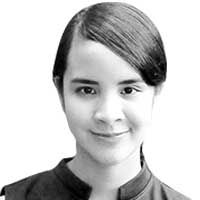Shapes of the land: Can Southeast Asia be tied together?


Whenever countries are clumped together in one short-lived little village otherwise known as the international exhibition, questions often recur to me. Two of which: In what way do we treat nationalism as a kind of performance? When we ask our artists to present a work, in what way are we actually asking them to represent a place?
Dr. Patrick Flores, art historian and curator of the recently opened “Ties of History,” shares his reflection on the role that nationality plays in the practice of art-making. While there are those who say that a nation is no longer relevant, Flores contends, “It is, but as one moment in the life of the artist. It’s not something you can dismiss easily but (neither does) nationality determine (the totality of) an artist’s life.”
What would it mean, then, to have a show that puts focus on the region to which the nation belongs?
“Ties of History” gathers the works of 10 artists from the Southeast Asian region: Amanda Heng (Singapore), Roberto Feleo (Philippines), Anusapati (Indonesia), Do Hoang Tuong (Vietnam), Savanhdary Vongpoothorn (Laos), Chris Chong Chan Fui (Malaysia), Jedsada Tangtrakulwong (Thailand), Min Thein Sung (Myanmar), Vuth Lyno (Cambodia), and Yasmin Jaidin (Brunei). In bringing together practitioners across different generations, the exhibit displays the breadth of moments in art history from the ’70s to the present.

Senator Loren Legarda, who has given major support for Philippine contemporary art projects, says, “I am proud of this exhibition, which gathers artists from the ASEAN member states. This is not only a showcase of contemporary art, but is also an attempt to strengthen the ties that bind us.”
Flores also considers it a test case in exhibition-making in Manila. On view until Oct. 6, “Ties of History” runs simultaneously in three venues: The Metropolitan Museum which is part of the old city facing Manila Bay, Yuchengco Museum which stands at the riotous heart of the Makati business district, and the Vargas Museum located within “the university in a rainforest.” This decision, and also the way that Flores describes these three spaces, feels to me an extension of the exhibition theme, with the way that it imagines its audience: people whose experiences are shaped by the spaces they occupy.
I went to the opening of the Metropolitan exhibit last Aug. 8. Scattered across the space are particular markers of culture: Feleo’s kings and babaylans with their respective ensembles indicating which myths and memories have conjured them; and Heng’s “Singirl” photographs referencing (or even satirizing) the image of the Singaporean girl dreamed up by the marketing campaigns of Singaporean Airlines.
It’s a bit uncanny seeing the gentle, smiling Heng appear again and again against popular shops and markets. It makes me wonder for instance about the overlap of art and marketing: their similar uses of repetition, and how much of identity is manufactured and (re)produced by images relentlessly repeating.
But beyond clear-cut information gleaned from representation, the show is also dealing with markers that are mute. Jaidin forms mounds and shapes out of soil, salt, and sugar. While particles are significant for their provenance — fractions capable of standing in for the larger whole — what else can sugar be but white? These ubiquitous presences are nonetheless silent about the worlds from which they come — may they be contested territories off the coast of Brunei or worlds of belief spanning the mystical and the mad.

“Thoamada II” by Vuth Lyno (Cambodia)
Part of the curator’s basis for choosing the artists is how their practices display a “strong engagement with material and a strong engagement with the world from which the material emerges.” In this same vein, Vongpoothorn’s work feels like a silent palimpsest of lands. Her woven scrolls and rice paper, stained by ink culled and mixed from different continents, are referencing local myths and issues of migration. In both Jaidin’s and Vongpoothorn’s practices, places are distilled into bits and stains. They bring to mind how art-making draws from the real-world habit of mark-making, and how materials ground our ties to the land, which can sometimes be territory or currency, a physical place or an imagined region.
Elsewhere, other issues are probed, like queer identity in Lyno’s series of photographs. We peer into houses of queer families and we stand in a closed ring of painted faces, like welcome interlopers gawking at faces deemed different, and recognize features similar to our own.
I wonder, when we walk into exhibitions celebrating diversity (and its marketed beauty), how much are we actually looking for sameness
“What exactly is the ASEAN identity other than a melting pot?” asks NCCA Chairman Virgilio Almario at the Met Museum opening. The exhibition refreshingly asserts no grand generalization. One curatorial decision was to refrain from putting labels of countries—like screaming flags asserting territories — in each artist’s work. We’ll need to read through the curatorial notes to discover where they come from.
For how can artists represent one place when they themselves are a palimpsest of places? Space determines experience, but not identity. It’s the job of marketing campaigns, I think, to produce singular ideals. But here, we’re not asked to answer what the ASEAN identity is (or even if there is one), but only to experience the stains on rice paper, the brownness of skins, and the whiteness of salt.

“Singirl Revisits: Railway” and “Singirl Revisits: BT Brown” by Amanda Heng (Singapore)
* * *
“Ties of History” runs until Oct. 6 at the Metropolitan Museum of Manila, Yuchengco Museum, and Vargas Museum. The project is presented by the National Commission for Culture and the Arts (NCCA) through the Dalubhasaan para sa Edukasyon sa Sining at Kultura (DESK) with the support of the Office of Senator Loren Legarda.



















